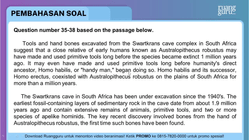Iklan
Pertanyaan
Question number 35-38based on the passage below. Tools and hand bones excavated from the Swartkrans cave complex in South Africa suggest that a close relative of early humans known as Australopithecus robustus may have made and used primitive tools long before the species became extinct 1 million years ago. It may even have made and used primitive tools long before humanity's direct ancestor, Homo habilis, or "handy man," began doing so. Homo habilis and its successor, Homo erectus, coexisted with Australopithecus robustus on the plains of South Africa for more than a million years. The Swartkrans cave in South Africa has been under excavation since the 1940's. The earliest fossil-containing layers of sedimentary rock in the cave date from about 1.9 million years ago and contain extensive remains of animals, primitive tools, and two or more species of apelike hominids. The key recent discovery involved bones from the hand of Australopithecus robustus, the first time such bones have been found. The most important feature of the Australopithecus robustus hand was the pollical distal thumb tip, the last bone in the thumb. The bone had an attachment point for a "uniquely human" muscle, the flexor pollicis longus, that had previously been found only in more recent ancestors. That muscle gave Australopithecus robustus an opposable thumb, a feature that would allow them to grip objects, including tools. The researchers also found primitive bone and stone implements, especially digging tools, in the same layers of sediments. Australopithecus robustus were more heavily built- more "robust" in anthropological terms-than their successors. They had broad faces, heavy jaws, and massive crushing and grinding teeth that were used for eating hard fruits, seeds, and fibrous underground plant parts. They walked upright, which would have allowed them to carry and use tools. Most experts had previously believed that Homo habilis were able to supplant Australopithecus robustus because the former's ability to use tools gave them an innate superiority. The discovery that Australopithecus robustus also used tools means that researchers willhave to seek other explanations for their extinction. Perhaps their reliance on naturally occurring plants led to their downfall as the climate became drier and cooler, or perhaps Homo habilis, with their bigger brains, were simply able to make more sophisticated tools. According to the passage, which of the following statements is not physical feature of Australopithecus robustus?
Question number 35-38 based on the passage below.
Tools and hand bones excavated from the Swartkrans cave complex in South Africa suggest that a close relative of early humans known as Australopithecus robustus may have made and used primitive tools long before the species became extinct 1 million years ago. It may even have made and used primitive tools long before humanity's direct ancestor, Homo habilis, or "handy man," began doing so. Homo habilis and its successor, Homo erectus, coexisted with Australopithecus robustus on the plains of South Africa for more than a million years.
The Swartkrans cave in South Africa has been under excavation since the 1940's. The earliest fossil-containing layers of sedimentary rock in the cave date from about 1.9 million years ago and contain extensive remains of animals, primitive tools, and two or more species of apelike hominids. The key recent discovery involved bones from the hand of Australopithecus robustus, the first time such bones have been found.
The most important feature of the Australopithecus robustus hand was the pollical distal thumb tip, the last bone in the thumb. The bone had an attachment point for a "uniquely human" muscle, the flexor pollicis longus, that had previously been found only in more recent ancestors. That muscle gave Australopithecus robustus an opposable thumb, a feature that would allow them to grip objects, including tools. The researchers also found primitive bone and stone implements, especially digging tools, in the same layers of sediments.
Australopithecus robustus were more heavily built- more "robust" in anthropological terms-than their successors. They had broad faces, heavy jaws, and massive crushing and grinding teeth that were used for eating hard fruits, seeds, and fibrous underground plant parts. They walked upright, which would have allowed them to carry and use tools. Most experts had previously believed that Homo habilis were able to supplant Australopithecus robustus because the former's ability to use tools gave them an innate superiority. The discovery that Australopithecus robustus also used tools means that researchers will have to seek other explanations for their extinction. Perhaps their reliance on naturally occurring plants led to their downfall as the climate became drier and cooler, or perhaps Homo habilis, with their bigger brains, were simply able to make more sophisticated tools.
According to the passage, which of the following statements is not physical feature of Australopithecus robustus?
broad faces
heavy jaws
walked upright
bigger brain
massive crushing and grinding teeth
Iklan
N. Puspita
Master Teacher
2
0.0 (0 rating)
Iklan
Pertanyaan serupa
RUANGGURU HQ
Jl. Dr. Saharjo No.161, Manggarai Selatan, Tebet, Kota Jakarta Selatan, Daerah Khusus Ibukota Jakarta 12860
Produk Ruangguru
Bantuan & Panduan
Hubungi Kami
©2026 Ruangguru. All Rights Reserved PT. Ruang Raya Indonesia

















